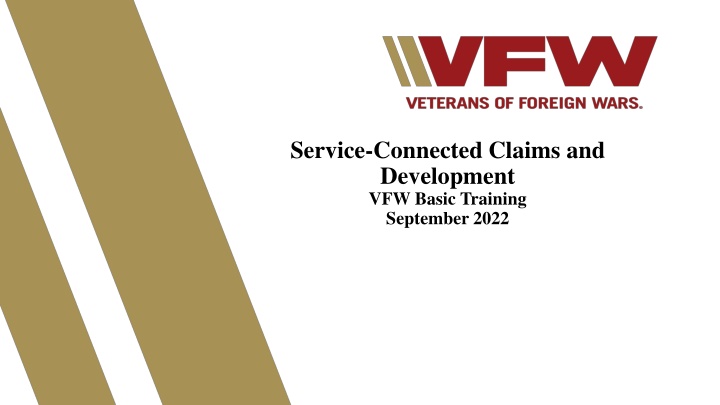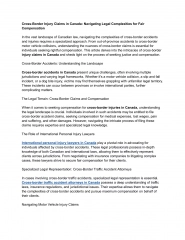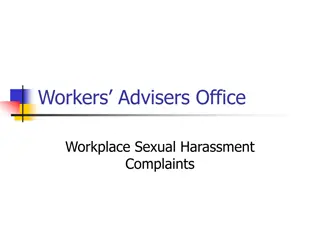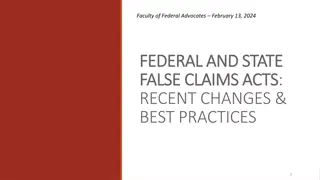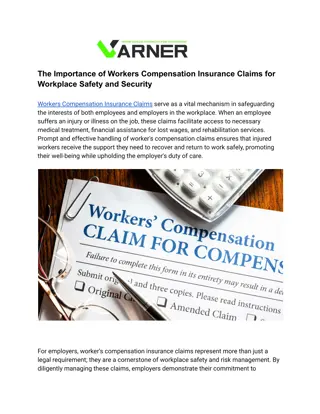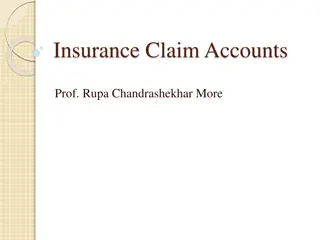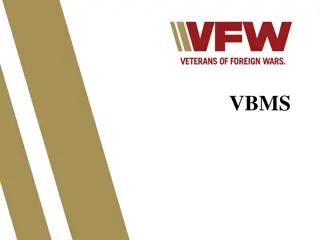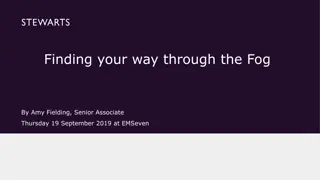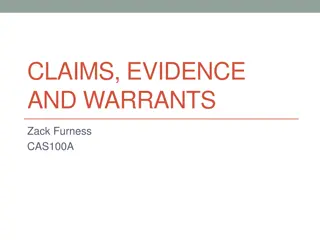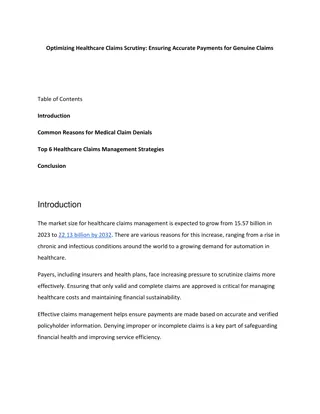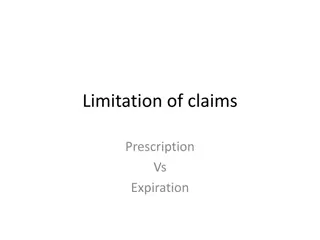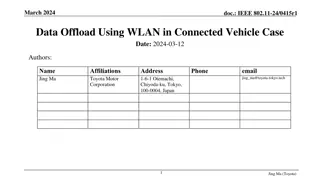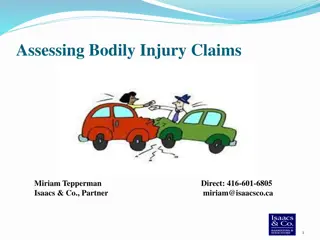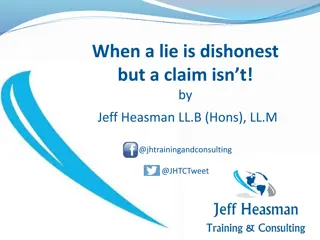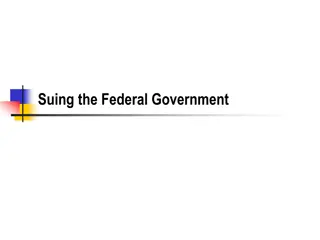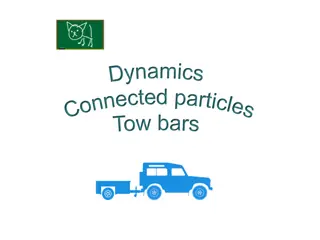Service-Connected Claims and Development
Enhance your knowledge on service-connected claims and development through the VFW Basic Training in September 2022. This training provides valuable insights and resources to help you navigate the complexities of claiming benefits and understanding the process involved. Whether you are a veteran or a family member seeking guidance, this training equips you with essential information to effectively pursue your claims.
Download Presentation

Please find below an Image/Link to download the presentation.
The content on the website is provided AS IS for your information and personal use only. It may not be sold, licensed, or shared on other websites without obtaining consent from the author.If you encounter any issues during the download, it is possible that the publisher has removed the file from their server.
You are allowed to download the files provided on this website for personal or commercial use, subject to the condition that they are used lawfully. All files are the property of their respective owners.
The content on the website is provided AS IS for your information and personal use only. It may not be sold, licensed, or shared on other websites without obtaining consent from the author.
E N D
Presentation Transcript
Service-Connected Claims and Development VFW Basic Training September 2022
WHY IS SERVICE CONNECTION IMPORTANT? Compensation A monthly payment made by the VA to a veteran because of a service- connected disability. 38 CFR 3.4 (a) 2
WHY IS SERVICE CONNECTION IMPORTANT? Health Care FREE VA health care is provided for all service-connected disabilities *Note: there is another category of service connection for treatment purposes only: Establishes health care but not compensation: special eligibility to service connection solely for treatment purposes 3
Common Confusion Many veterans will confuse compensation with other benefits such as pension or military retirement. It is your job to explain the differences between these programs and identify entitlement to the greatest benefit possible. 4
COMMON ELEMENTS OF SERVICE CONNECTION Current disability Incurred or Aggravated In line of duty In the active military, naval, or air service 38 CFR 3.1(k) 5
COMMON ELEMENTS OF SERVICE CONNECTION Disability: Must have a current disability from injury/disease Incurred: Event occurs anytime while on active duty (on leave, ACDUTRA, INACDUTRA) Aggravated: Disability made worse during service or due to service- connected disability (more on this later) In line of duty: Considered in line of duty unless willful misconduct is shown 38 CFR 3.301 6
THE FOUR (4) PREFERRED PATHS TO SERVICE CONNECTION There are four preferred paths to service connection: Direct Aggravation Secondary Presumptive 7
DIRECT SERVICE CONNECTION Three elements of Service Connection: 1. Current Disability (established by lay or medical evidence) 2. Event in Service (injury, exposure to toxic substance, noise, trauma) 3. Link between Current Disability and Event in Service, termed Nexus (For BDD claims the event in service is the link) Caluza v. Brown, 7 Vet.App. 498 (1995) 8
DIRECT SERVICE CONNECTION With Direct Service Connection, the current disability can develop or get worse many years after service, it just has to be due to the in-service event or exposure. This can get more difficult to prove years after service, and will usually require a nexus opinion Examples: Late-onset PTSD, Skin cancer due to sun exposure in tropical/desert locations, Disability due to exposure to asbestos, jet fuel, etc. 38 CFR 3.303(d) Post service initial diagnosis of disease 9
DIRECT SERVICE CONNECTION: EVIDENCE Service Treatment Records Personnel and Unit Records Private Medical Records Medical Opinions C&P exams/DBQs Secondary Evidence showing Incurrence Letters, Diaries, Cancelled Checks, Receipts, Newspaper Articles, Insurance Exams, Workers Compensation Claims, Lawsuits 10
DIRECT SERVICE CONNECTION: WHAT IF YOU HAD THE SAME PROBLEM BEFORE SERVICE? 38 CFR 3.304(b) Presumption of Soundness When accepted for military service, presumed sound or healthy EXCEPT FOR: Conditions that are noted on entrance physical OR Clearly and unmistakably pre-existing service Signed statement of the veteran that disability pre-existed service is of no effect unless other data supports it was pre-existing 11
AGGRAVATION Two types of Aggravation: 38 CFR 3.306: Aggravation of Pre-Service Disability 38 CFR 3.310(b): Aggravation of Non-Service Connected Disability After Service Remember 38 CFR 3.1(k): incurred or aggravated 12
AGGRAVATION OF PRE-EXISTING DISABILITIES DURING SERVICE 38 CFR 3.306 If accepted into service with pre-existing disability And disability worsens during active service (remember anytime during active service) Pre-existing disability can now be service-connected Unless evidence shows it wasn't aggravated beyond the natural progress of the condition 13
AGGRAVATION OF PRE-EXISTING DISABILITIES AFTER SERVICE 38 CFR 3.310(b) Non-service connected disability pre-existed service or happened after service but not caused by military service The non-service connected disability cannot be the result of willful misconduct Example: Veteran develops a non-service-connected skin condition, and service-connected diabetes makes the skin condition worse. 14
AGGRAVATION OF PRE-EXISTING DISABILITIES AFTER SERVICE 38 CFR 3.310(b) Medical evidence is required Rating a non-service-connected condition that is aggravated after service: Establish baseline severity of condition if service-connected condition wasn't making it worse Compensated for the difference between baseline and current severity 15
SECONDARY SERVICE CONNECTION (SERVICE-CONNECTED DISABILITY CAUSES ANOTHER DISABILITY) 38 CFR 3.310(a) This path is similar to aggravation, but the service-connected disability actually CAUSES another disability Unlike with aggravation, there is no need to establish a baseline Disability is rated the same as if directly service-connected Some disabilities are already recognized as secondary in the regulations 16
SECONDARY DISABILITIES RECOGNIZED BY CFR Certain disabilities are recognized in the CFR as causing other disabilities Some examples include: Above the knee amputation or double ankle amputation causes Cardiovascular disease 38 CFR 3.310(c) Traumatic brain injury causes Parkinsonism, Seizures, Depression, certain dementias and certain hormone deficiencies 38 CFR 3.310(d) 17
SECONDARY DISABILITIES RECOGNIZED BY M21-1 Certain disabilities are recognized in the M21-1 as causing other disabilities Some examples include: Diabetes with nephropathy causes Hypertension (M21-1 V.iii.11.2.g) Many other common complications are listed in the M21-1 sections for rating specific disabilities but will need a medical opinion. 18
MEDICAL EVIDENCE REQUIRED IF NOT LISTED IN CFR OR M21-1 A medical opinion that a service-connected condition or treatment for a service-connected condition caused another disability is required if the disability is not already established as secondary in the regulation. 19
WILLFUL MISCONDUCT AND ALCOHOL OR DRUG ABUSE 38 CFR 3.301(c)(2) and (3) Disabilities that are the result of Alcohol or Drug Abuse can't be directly service-connected. However, if the substance is used because of a service-connected condition, it is not willful misconduct, and resulting disabilities can be secondarily service-connected Example: Veteran has cirrhosis of the liver, due to alcohol addiction. If alcohol addiction is result of a service-connected disability (for example, PTSD, or severe pain due to orthopedic condition), cirrhosis of the liver may be secondarily service-connected 20
PRESUMPTIVE SERVICE CONNECTION Presumptive service connection can be granted if the veteran meets certain criteria as put forth in 38 CFR. For presumptive service connection we know some facts about the veteran, and we are presuming that certain disabilities are service-connected because of those facts. 21
WHAT IS A PRESUMPTION? There are many presumptions in veterans law (Title 38 USC and Title 38 CFR) Some examples: Combat Veteran Presumption: Because veteran was in combat, we presume that their statements as to disabilities that occurred during combat are true. 38 USC 1154(b) Presumption of Soundness: Because the veteran was found fit for service, we presume that he or she did not have any disabilities other than those noted on the physical exam. 38 CFR 3.304(b) These presumptions both help to prove in-service incurrence of a disability 22
PRESUMPTIONS THAT PROVE BOTH IN- SERVICE EVENT AND NEXUS Each presumption regulation lists: 1. Reason why there is a presumption (examples: radiation exposure, POW status, herbicide exposure, etc.) 2. Facts about veteran s service that must be true - When and where they served - Sometimes, MOS or job function 3. List of disabilities associated with this presumption If the veteran s service meets the requirements, all you must show is evidence of a current disability that is on the list of presumptive conditions. 23
Particulate Matter Presumptive Conditions In 2021, VA recognized the following conditions as presumptive to particulate matter exposure: Asthma Rhinitis Sinusitis, to include Rhinosinusitis To qualify the veteran must have: Served any length of time in the Southwest Theater of Operations during the Persian Gulf War, or Served any length of time in Afghanistan, Syria, Djibouti or Uzbekistan on or after September 19, 2001 and Manifests one of the following to any degree within 10 years from the date of separation from military service: 24
LIMITATIONS OF PRESUMPTIONS Strategy: What if the veteran meets the time period and facts of service, but has a disability that is not listed in the regulation? Possible actions to take? 25
LIMITATIONS OF PRESUMPTIONS If it is not on the presumptive list, you will likely need a good medical opinion to lead to a grant of compensation. ALWAYS file claims as long as they have: A current, chronic disability and some evidence of exposure unless it is clear the disability was caused by an incident after service such as a workplace accident BE REALISTIC when explaining processing timelines and chances of success Get the facts on record in case the law changes in the future 26
THREE PATHS AS-IF SERVICE CONNECTED The next three paths to service connection treat the disability as if it were service connected The veteran will be paid compensation but may not receive all of the ancillary benefits that normally come with service connection 27
PAIRED ORGANS 38 CFR 3.383 1. When there is service-connected severe disability (usually loss or loss of use) of certain organs or extremities AND 2. Non-service-connected disability of the paired organ or extremity BOTH organs or extremities will be treated as service-connected for determining compensation Applies to: Hands, Feet, Eyes, Ears, Kidneys, and Lungs 28
PAIRED ORGANS 38 CFR 3.383 Why? Rating Schedule percentages assume that if only one of the organs/extremities is impaired, the veteran can compensate for the impaired/missing organ If both are impaired or missing, veteran is less able to compensate Example: Veteran has service-connected deafness of one ear due to antibiotic use in service. He also has non-service-connected hearing loss in the other ear due to a scuba diving incident. 38 CFR 4.85(f) Without paired organs regulation: 10% rating for one ear With paired organs regulation: Rating for both ears, up to 100% 29
COMPENSATED WORK THERAPY OR REHABILITATION 38 USC 1151 and 38 CFR 3.361 If the Veteran is participating in VA sponsored CWT, it s treated like worker s compensation Must have suffered additional disability or death while in CWT Not due to willful misconduct Apply for compensation using same process as other claims: 21-526EZ 30
VA FAULT/NEGLIGENCE 38 USC 1151 and 38 CFR 3.361 1. Suffered additional disability or death 2. Due to VA medical care or Failure of VA to diagnose/treat (Not due to the natural progress of disease) 3. VA was at fault 31
VA FAULT/NEGLIGENCE Three ways to prove VA Fault: 38 CFR 3.361(d) 1. VA failed to exercise the degree of care that would be expected of a reasonable health care provider, OR 2. VA furnished hospital care, medical or surgical treatment, or examination without the veteran's informed consent, OR 3. The additional injury or death was not reasonably foreseeable (unexpected based on the usual effects of treatment) A MEDICAL OPINION IS NEEDED FOR THIS 32
VA FAULT/NEGLIGENCE NOTE: Remember, this path is AS-IF Service Connected If granted compensation under 38 USC 1151, veteran will not get all ancillary benefits such as DEA because the condition is not actually service-connected You may be able to choose a better path even if negligence is an issue - Which type of claim is it if a service-connected disability gets worse due to treatment? - Which path is it if treatment for a service-connected disability causes another condition? File on VA Form 21-526EZ 33
VA FAULT/NEGLIGENCE NOTE on Federal Tort Claims and Offsets: The veteran/claimant can also file a Federal Tort Claim against a federal agency or employee. VFW CANNOT assist in these claims. There may be an offset of benefits (won t receive VA compensation and award from Federal Tort Claim settlement at same time) *IMPORTANT: we are not allowed to recommend specific lawyers. Direct the veteran to Legal Aid or LawHelp.org for clearinghouse of legal aid providers. 34
THOUGHTS ON SERVICE CONNECTION Think about which path makes most sense for the veteran based on the facts and evidence Direct, Secondary, Presumptive paths are best, then Aggravation, then as-if service-connected paths. Do not need to state the path if it is direct service connection, that will always be considered. Recommend stating the path on claim form if it is NOT direct service connection. In the end, it is the veteran s or survivor s claim. Explain clearly the evidence they will need to provide but never dissuade them from filing, especially if it is an original claim. 35
Now that we have discussed the major points of service connection, let s talk about claims development and VA s duties to notify and assist veterans with their claims. 36
MAJOR POINTS IN THE CLAIMS PROCESS: To trigger a C&P exam, the claim must be plausible To have the claim granted, the claim must be probable The claim need not be conclusive, only at least as likely as not (50/50) It is your responsibility to guide the veteran in preparing a claim with the best chance of success 37
DUTIES AND RESPONSIBILITIES Your role is to assist the veteran in developing and submitting a timely, complete, and accurate claim. Once certain criteria are met, VA is required by law to assist the veteran in obtaining required documentation to support their claim and continue development. Neither of which relieves the veteran of their ownership of the claim. The veteran also has a duty to assist you and the VA in accomplishing the mission. It is THEIR claim. 38
CRITERIA: SUBSTANTIALLY COMPLETE CLAIM An application is only complete if the following are included (38 CFR 3.160): Claimants Name Service Information Benefit claimed Signature For Compensation: disabilities for which benefit is claimed (listing diagnosis or chronic symptoms) For Pension/parent s DIC:statement of income 39
DEVELOPMENT OF A CLAIM CONSISTS OF: Obtaining any and all available evidence; Understanding the process including: time frames and reasonable expectations; Compensation requires a current diagnosed disability, proof of incurrence, and a nexus; Pension requires medical evidence or presumption of a permanent and total (over age 65) and income/net worth evidence WITHOUT PROPER DEVELOPMENT THE CLAIM WILL FAIL 40
EVIDENCE Evidence is every type of proof offered to establish a fact. (M21-1 V.ii.1.A.1.a. ) Testimonial Oral and written statements Documentary documents Real a tangible object Demonstrative illustrates testimony of a witness Direct capable of proving by itself of proving a fact or issue Circumstantial allows the fact finder to deduce a certain fact from other facts that can be proven 41
EVIDENCE Evidence must be on or accompanied by a VA approved standardized form; if you are not submitting the evidence at the same time as the claim, include a 21-4138 explaining the evidence and reason for its submittal. VA forms are updated frequently and can be obsolete in a short period of time. Visit VA s website for latest edition or you may use the forms provided in VetraSpec. REMEMBER web addresses that end in .com are not government web addresses and are often outdated or contain incorrect information. 42
LAY EVIDENCE 38 CFR 3.159(a)(2) Lay evidence is: any evidence not requiring that the writer have specialized education, training, or experience. competent if it is provided by a person who has knowledge of facts or circumstances and conveys matters that can be observed and described by a lay person. used to fill in blanks and can help to balance other evidence 43
EXAMPLES OF LAY EVIDENCE Some Examples include: Veteran s statement (spoken or written) Lay statement (spouse, friend, family) Buddy statement Photographs Newspaper clippings Performance evaluations Copies of bills paid on time Q: What if veteran s uncle is a nurse who wants to provide testimony? 44
LAY TESTIMONY REQUIRES: Credibility Person making statement must be believable e.g. malingering, exaggeration, motive Competency Person s words have value e.g. description of symptoms vs diagnosis M21-1 V.ii.1.A.2.b accept evidence at face value 45
VALUABLE LAY TESTIMONY Veteran s description of their own experience Witness to same in-service event (another veteran) Witness of current symptoms (spouse, co-worker, neighbor) Opinion of how disability is related to event in service Comparison of symptoms before disability and now Spouse also heard what doctor said Description of how bad pain can get Example of how symptoms impact daily life Veteran reports unit, rank, and theater 46
COMBAT VETERANS 38 CFR 3.304(d) Combat. Satisfactory lay or other evidence that an injury or disease was incurred or aggravated in combat will be accepted as sufficient proof of service connection if the evidence is consistent with the circumstances, conditions or hardships of such service even though there is no official record of such incurrence or aggravation. 47
TREATMENT RECORDS Submit all available treatment records (both VA and private) In most cases, it is best for the veteran to obtain private treatment records. Request all records related to the claim using VA Forms 21-4142 and 21- 4142a VA does not pay for private records If a claim has been filed in the past, VA has those records; submit updates that occurred after the previous claim was filed. 48
OTHER HELPFUL EVIDENCE Some other common types of evidence that may be helpful: Journals Medical Studies HR Reports Notes/letters home What other types of evidence may be available? 49
DESTROYED NPRC RECORDS Note: In 1973, a fire at the National Personnel Records Center (NPRC) in St. Louis destroyed records held for veterans who were discharged from the Army and Air Force during certain periods of time. Records may have been destroyed in the fire if discharged from the Army between November 1, 1912 and January 1, 1960, or if discharged from the Air Force between September 25, 1947 and January 1, 1964. If your veteran was affected by this, records can be reconstructed by using the following forms: NA Form 13055 (medical records) NA Form 13075 (service verification) 50
